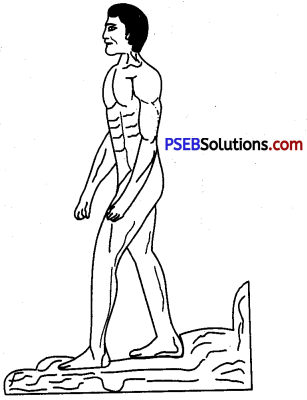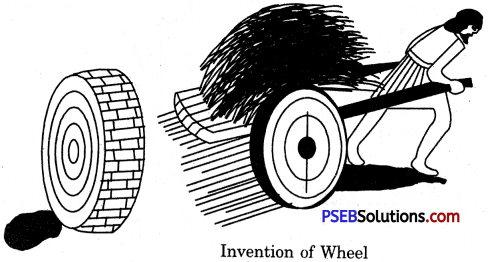Punjab State Board PSEB 6th Class Social Science Book Solutions History Chapter 9 Early Man: The Stone Age Textbook Exercise Questions and Answers.
PSEB Solutions for Class 6 Social Science History Chapter 9 Early Man: The Stone Age
SST Guide for Class 6 PSEB Early Man: The Stone Age Textbook Questions and Answers
I. Answer the following questions :
Question 1.
What do you know about the Old Stone Age?
Answer:
The Old Stone Age is the period when man was a hunter-gatherer. In this age, man’s life depended upon natural objects. He did not know about fire, so he used to eat the fruit of the trees and the flesh of animals. In order to protect himself from wild animals, he moved in groups and at night he took shelter on trees or in caves and rock shelters. He went about naked, but sometimes he wore skins of animals and leaves or bark of trees, to protect himself from extreme heat or cold. For hunting animals; he used stone weapons or branches of trees.

Early Man
Question 2.
Write five important characteristics about the Neolithic Age.
Answer:
The third and the last phase of Stone Age is known as the Neolithic Age. Five important things about this age are as ahead :
- Man began to live at one place permanently. He had started growing and cooking food.
- Man’s implements had become more refined. They were sharp and lighter in weight, that made them more effective.
- Man learnt to make vessels of clay to store his food and also to cook it.
- Man learnt to express his artistic instincts by drawing figures on the walls of caves and rock-shelters where he lived.
- Man learnt to make beads of various semi-precious stones, terracotta, ivory, etc., and used them as jewellery.
![]()
Question 3.
What do you know about the Mesolithic Age?
Answer:
The Mesolithic Age began after the Palaeolithic Age. During this period man’s life improved a bit. He learnt several new things. In place of crude pieces of broken stone, he started making stone- weapons such as axes, spears and cleavers, which were pointed and chiseled. He tied them to long sticks of wood. He also learnt that certain types of food-grains could be stored for a long time. Therefore, he began to gather food-grains. Except these, the caves and rock- shelters, he came to know how to build small huts of reed, wood and leaves. Consequently, man began to lead a settled life in villages.
Question 4.
How did the invention of wheel help man?
Answer:
The invention of wheel led to a big advance in the pattern of living of man. It made life very much easier and comfortable. With the help of wheel, man was able to make wheeled-carts, which could be drawn by animals. It made travel and transport easier. It improved the making of pottery.

Invention of Wheel
Question 5.
Write a note on cave paintings.
Answer:
While living in caves and rock-shelters, early man used to draw figures of human beings, animals and hunting scenes on the walls with the help of pointed stones and pigments. These figures were usually line drawings but sometimes he coloured such figures with the help of a bamboo brush. These rock-drawings have been discovered at several places in India and other parts of the world. The cave-paintings of Bhimbaithaka, near Bhopal in Madhya Pradesh, are worth seeing, in which people are seen dancing. It shows that dancing was a major source of entertainment in the Stone Age and people danced in groups.
II. Match the columns :
Question 1.
| A | B |
| (i) Paleolithic | (a) Caveman |
| (ii) Mesolithic Age | (b) Cave paintings |
| (iii) Bhimbaithaka | (c) Old Stone Age |
| (iv) Hunter-gatherer | (d) Middle Stone Age |
Answer:
Correct columns :
| A | B |
| (i) Paleolithic | (a) Caveman |
| (ii) Mesolithic Age | (d) Middle Stone Age |
| (iii) Bhimbaithaka | (b) Cave paintings |
| (iv) Hunter-gatherer | (c) Old Stone Age |
III. Write ‘true’ or ‘falses in the brackets given after each
Question 1.
Visit a museum and see the implements used by early man.
Answer:
Do it yourself.
![]()
Question 2.
Cut out diagrams of early man’s tools from an old history book and paste in your scrap book. ‘
Answer:
Do it yourself.
PSEB 6th Class Social Science Guide Early Man: The Stone Age Important Questions and Answers
Multiple Choice Questions
Question 1.
__________ is the place where the remains of tools, pots, buildings etc. were found.
(A) Site
(B) Factory
(C) Habitation
(D) Inscription.
Answer:
(A) Site.
Question 2.
__________ are places where people lived including cave and rock shelters.
(A) Site
(B) Habitation
(C) Palace
(D) Factory.
Answer:
(B) Habitation.
Question 3.
__________ was the place where people made tools.
(A) Site
(B) Habitation
(C) Factory
(D) Palace.
Answer:
(C) Factory.
![]()
Question 4.
The Mesolithic period was years ago.
(A) 12000-10,000
(B) 8,000-10,000
(C) 6,000-8,000
(D) 4,000-6,000.
Answer:
(A) 12,000-10,000.
Question 5.
The beginning of the Neolithic age __________
(A) 8, 000 years ago
(B) 10,000 years ago
(C) 6,000 years ago
(D) 4,000 years ago.
Answer:
(B) 10,000 years ago.
Question 6.
Early people painted on the of caves.
(A) walls
(B) roof
(C) floor
(D) All of these.
Answer:
(A) walls.
Question 7.
Tools in Hunsgi were made of.
(A) metal
(B) bone
(C) limestone
(D) stone.
Answer:
(C) limestone.
Question 8.
Which of these qualities are required to hunt animals?
(A) Alert
(B) Quick
(C) Presence of mind
(D) All of these.
Answer:
(D) All of these.
![]()
Question 9.
In which period were Ostriches found in India?
(A) Palaeolithic
(B) Mesolithic
(C) Stone
(D) Microlithic.
Answer:
(A) Palaeolithic.
Very Short Answer Type Questions
Question 1.
When did the man come on the earth?
Answer:
The man came on the earth about four million years ago.
Question 2.
What was the food of early man?
Answer:
The food of early man consisted of fruits, berries and flesh of animals.
Question 3.
What type of clothes did early man wear?
Answer:
Early man used skins of animals, bark of trees and large leaves as clothes.
![]()
Question 4.
Name a few implements of early man.
Answer:
Early man’s implements were made mostly of stone. These included crude axes, cleavers, spears, choppers, scrapers, etc.
Question 5.
What is a flint stone?
Answer:
A flint stone is a stone that produces sparks and fire.
Question 6.
What was the first mechanical device learnt by man?
Answer:
The use of solid logs as wheels was probably the first mechanical device learnt by man.
Question 7.
When did the settled life of early man become possible?
Answer:
The settled life of early man became possible when he learnt to produce food.
Question 8.
How did early man express his artistic instincts?
Answer:
Early man expressed his artistic instincts by drawing figures on the walls of caves and rock-shelters where he lived.
Question 9.
What is Bhimbaithaka?
Answer:
Bhimbaithaka is a place near Bhopal in Madhya Pradesh where rock-drawings of early man have been discovered.
Question 10.
What were ornaments of early man-made of?
Answer:
Ornaments of early man were made of semi-precious stones, terracotta, ivory, etc.
![]()
Question 11.
What is the literal meaning of the word ‘Paleolithic’?
Answer:
The word Paleolithic is made up of two Greek words- Palaeo and lithic. The meaning of Palaeo is old and the meaning of lithic is stone. So the literal meaning of Paleolithic is- old stone.
Question 12.
What is New Stone Age?
Answer:
New stone age was the period of history when early man domesticated animals and learnt the use of polished stone tools. It is also known as Neolithic period.
Question 13.
Which discoveries helped early man to lead a settled life?
Answer:
Beginning of agriculture, the taming of animals, discovery of metals and discovery of wheel were the discoveries that helped early man to lead a settled life.
Question 14.
Who is a Food-gatherer?
Answer:
Food-gatherer is a person who wanders from place to place in search of food. Man in Early Stone Age was a food-gatherer.
Question 15.
Who is a Food-producer?
Answer:
Food-producer is a person who produces plants and crops to meet his food requirements. In Neolithic period, man became food producer from food-gatherer.
Short Answer Type Questions
Question 1.
Why is early man called a wanderer?
Answer:
Early man did not know how to grow food. He ate fruit of trees and hunted whatever animals he could. So when he had eaten all that he could find in a certain place, he had to move on to some other places in search of food. That is why he is called a wanderer.
![]()
Question 2.
How had early man to defend himself from wild animals?
Answer:
Early man had to defend himself from wild animals either by hiding in caves and trees or by using his crude weapons against them and killing them. But the best mean of defence against animals was fire.
Question 3.
Why did early man start living at one place?
Answer:
It was the discovery of agriculture that made possible for early man to live at one place. Now he did not have to wander from place to place in search of food. He stopped being a nomad and settled down at one place as an agriculturist.
Question 4.
How was fire discovered?
Answer:
The striking together of two pieces of stone called ‘flint produced spark. When it touched dry leaves and twigs, it burst into a flame. This is how the fire was discovered.
Question 5.
How did the fire act as a source of comfort and protection for early inan?
Answer:
The fire acted- as a source of comfort and protection for early man in the following ways :
- At night when everyone crowded in a cave, a fire was kept burning at the entrance and this prevented the wild animals from entering the cave.
- In the cold of winter, the fire gave early man heat.
Question 6.
What were the advantages of wheels to early man?
Answer:
Early man took great advantages from the invention of wheel. It was very easy for him to carry a round object from one place to another by rolling it instead of carrying a cubical object. Early man must have learnt it by rolling logs of woods. This invention made the advancement quicker and easier for him. It helped him in easy transportation of goods and travel long distances. It also helped him in improving the making of different kinds of pots.
Long Answer Type Question
Question 1.
How did the domestication of animals help early man?
Answer:
Early man was a hunter. He killed animals for food. Then he began to domesticate them. This helped him in the following ways :
- Food: Man could get meat, milk, and butter from the domesticated animals.
- More Animals: Wild animals could only be killed and their flesh is eaten. But domesticated animals could be made to breed and provide more animals.
- Help in Agriculture: Animals could be used to draw the plow or the cart.
- Clothes: Man used the skin of animals as clothes.
- Weapons, Tools, etc: Man used the bones of animals to make weapons, tools, and even ornaments.